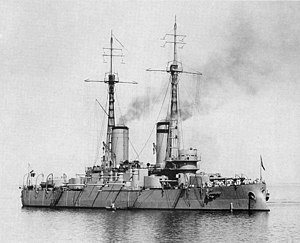Russian battleship Andrei Pervozvanny
 Andrei Pervozvanny in 1912
| |
| History | |
|---|---|
| Name | Andrei Pervozvanny |
| Namesake | Saint Andrew |
| Builder | Admiralty Shipyard, Saint Petersburg, Russia |
| Laid down | 11 May 1905 |
| Launched | 30 October 1906 |
| In service | 10 March 1911 |
| Acquired | November 1917 |
| Out of service | 1919 |
| Stricken | 21 November 1925 |
| Fate | Scrapped, 15 December 1923 |
| General characteristics as built | |
| Class and type | predreadnought battleship |
| Displacement | |
| Length | 460 ft (140.2 m) ( o/a ) |
| Beam | 80 ft (24.4 m) |
| Draft | 27 ft (8.2 m) |
| Installed power |
|
| Propulsion | 2 shafts; 2 triple-expansion steam engines |
| Speed | 18.5 knots (34.3 km/h; 21.3 mph) |
| Range | 2,100 nmi (3,900 km; 2,400 mi) at 12 knots (22 km/h; 14 mph) |
| Complement | 956 |
| Armament |
|
| Armor |
|
Andrei Pervozvanny (
Description
Andrei Pervozvanny was 454 feet (138.4 m)
Andrei Pervozvanny was equipped with two 4-cylinder
The main armament of the Andrei Pervozvanny class consisted of two pairs of
Based on the Russian experience at the
Service history

Andrei Pervozvanny was built by the
Andrei Pervozvanny was mostly inactive during the war as the Russian naval strategy in the Baltic was defensive and they did not intend to seek out the German fleet.[7] She ran aground in the Longgayen Pass on 12 November 1914. She was refloated on 14 November, repaired and returned to service.[8] Torpedo nets were fitted in early 1915 and the ship's torpedoes were removed in January 1916. In late 1916, four 76-millimeter (3 in) anti-aircraft guns were added.[9] The ship's crew joined the general mutiny of the Baltic Fleet in Helsinki on 16 March 1917, after they received word of the February Revolution in Saint Petersburg, and several of the ship's officers were murdered by the crew. The Treaty of Brest-Litovsk required the Soviets to evacuate their naval base at Helsinki in March 1918 or have their ships interned by newly independent Finland even though the Gulf of Finland was still frozen over. Andrei Pervozvanny and her sister ship the renamed Respublika, led the second group of ships on 5 April and reached Kronstadt five days later in what became known as the "Ice Voyage".[7]
After the
Notes
Footnotes
- ^ McLaughlin, pp. 180–181, 185
- ^ McLaughlin, pp. 181, 187
- ^ McLaughlin, p. 186
- ^ McLaughlin, p. 181
- ^ McLaughlin, p. 180
- ^ McLaughlin, pp. 188, 302
- ^ a b c McLaughlin, p. 188
- ^ Chernyshev, Alexander Alekseevich (2012). Погибли без боя. Катастрофы русских кораблей XVIII–XX вв [They died without a fight. Catastrophes of Russian ships of the XVIII-XX centuries] (in Russian). Veche.
- ^ McLaughlin, p. 302
- ^ a b McLaughlin, p. 322
- ^ Head, p. 223
- ^ Head, pp. 229, 232
- ^ Head, p. 233
- ^ Melnikov, p. 96.
References
- Head, Michael (2009). "The Baltic Campaign, 1918–1920, Pt. II". Warship International. XLVI (3): 217–39. ISSN 0043-0374.
- McLaughlin, Stephen (2003). Russian & Soviet Battleships. Annapolis, Maryland: Naval Institute Press. ISBN 1-55750-481-4.
- Melnikov, R. M. (2003, in Russian). Lineyny korabl "Andrey Pervozvanny" (1906–1925) (Линейный корабль "Андрей Первозванный" (1906–1925)). Saint Petersburg: Korabli i srazheniya. (no ISBN)
Further reading
- Campbell, N. J. M. (1979). "Russia". In Chesneau, Roger & Kolesnik, Eugene M. (eds.). Conway's All the World's Fighting Ships 1860–1905. New York: Mayflower Books. pp. 170–217. ISBN 0-8317-0302-4.
External links
- (in Russian) Magazine article on the ship
